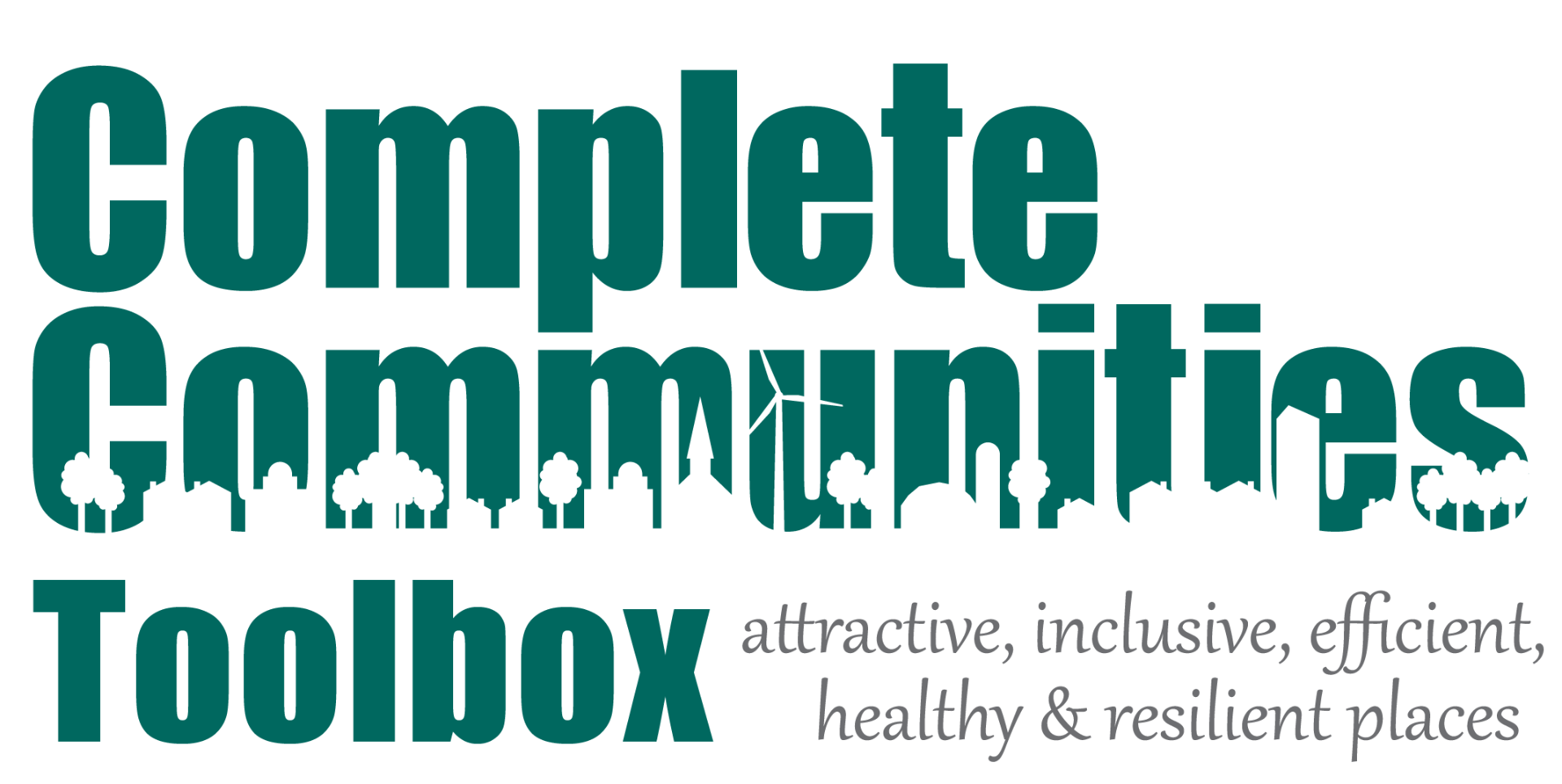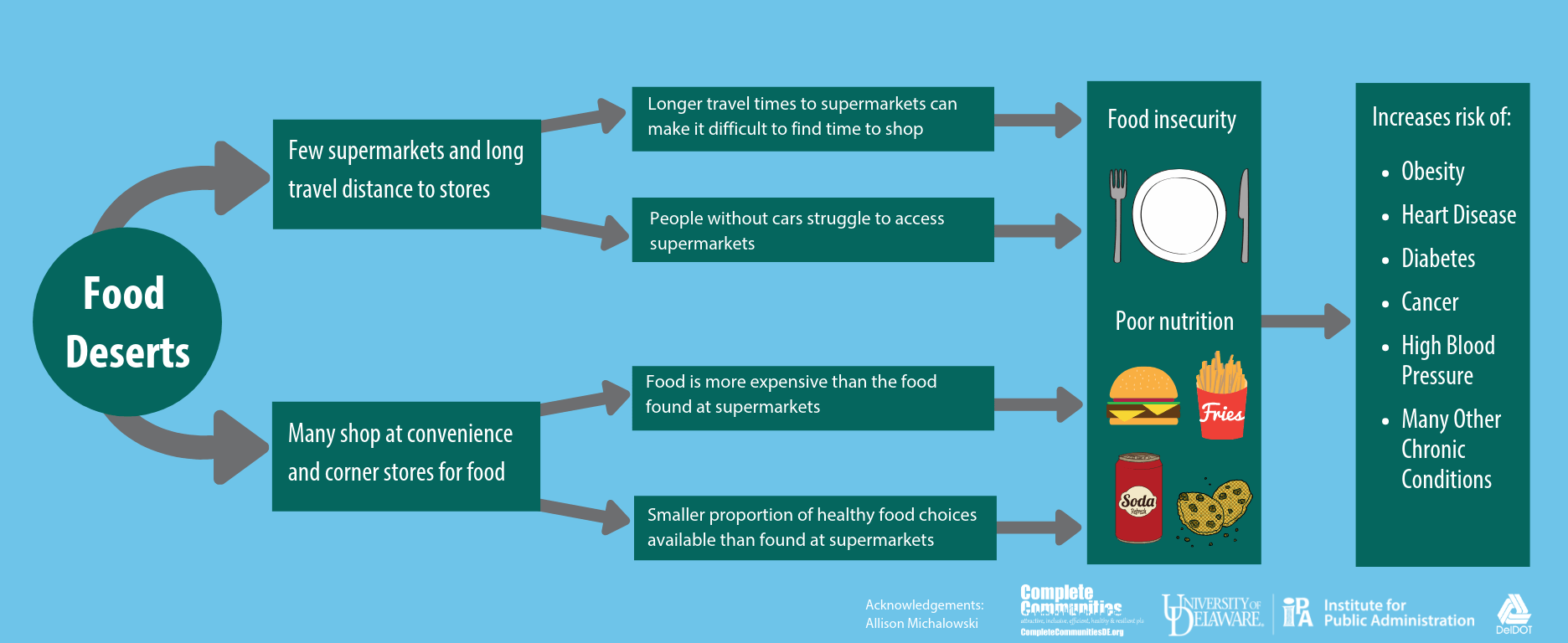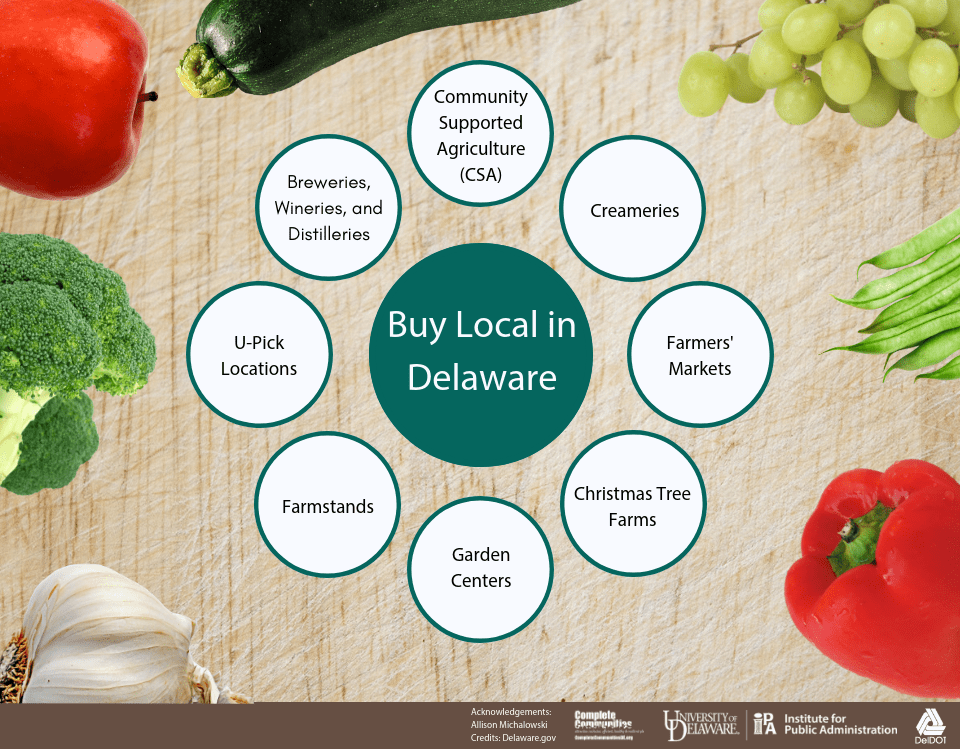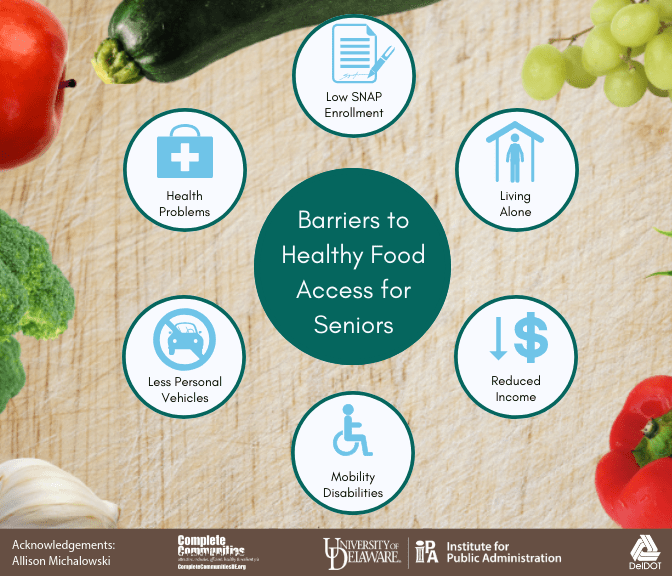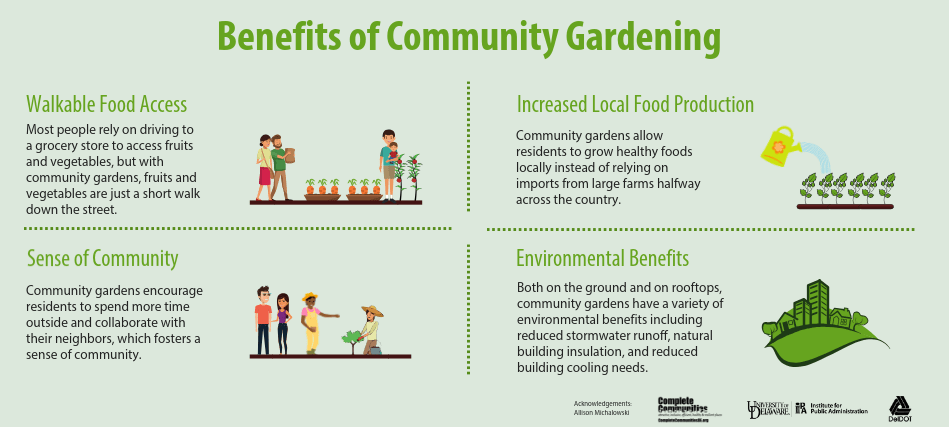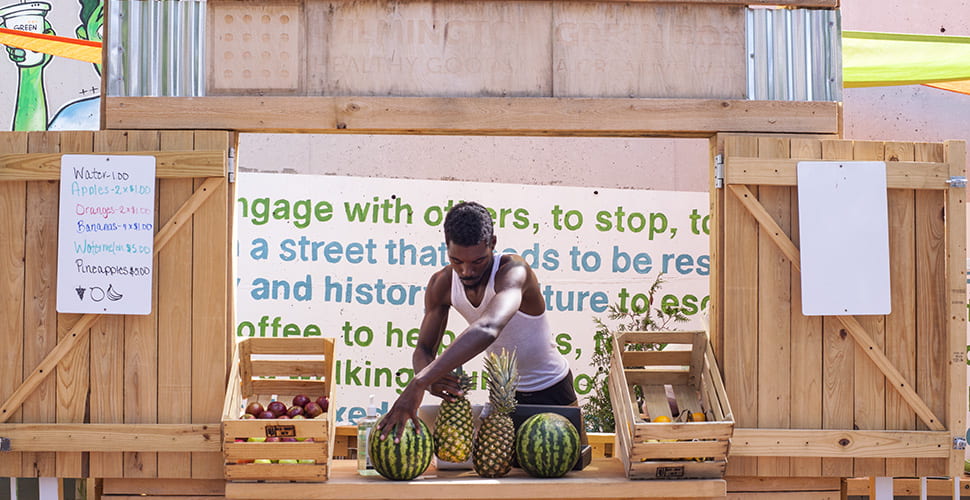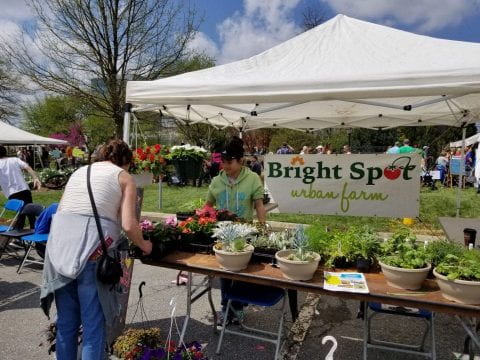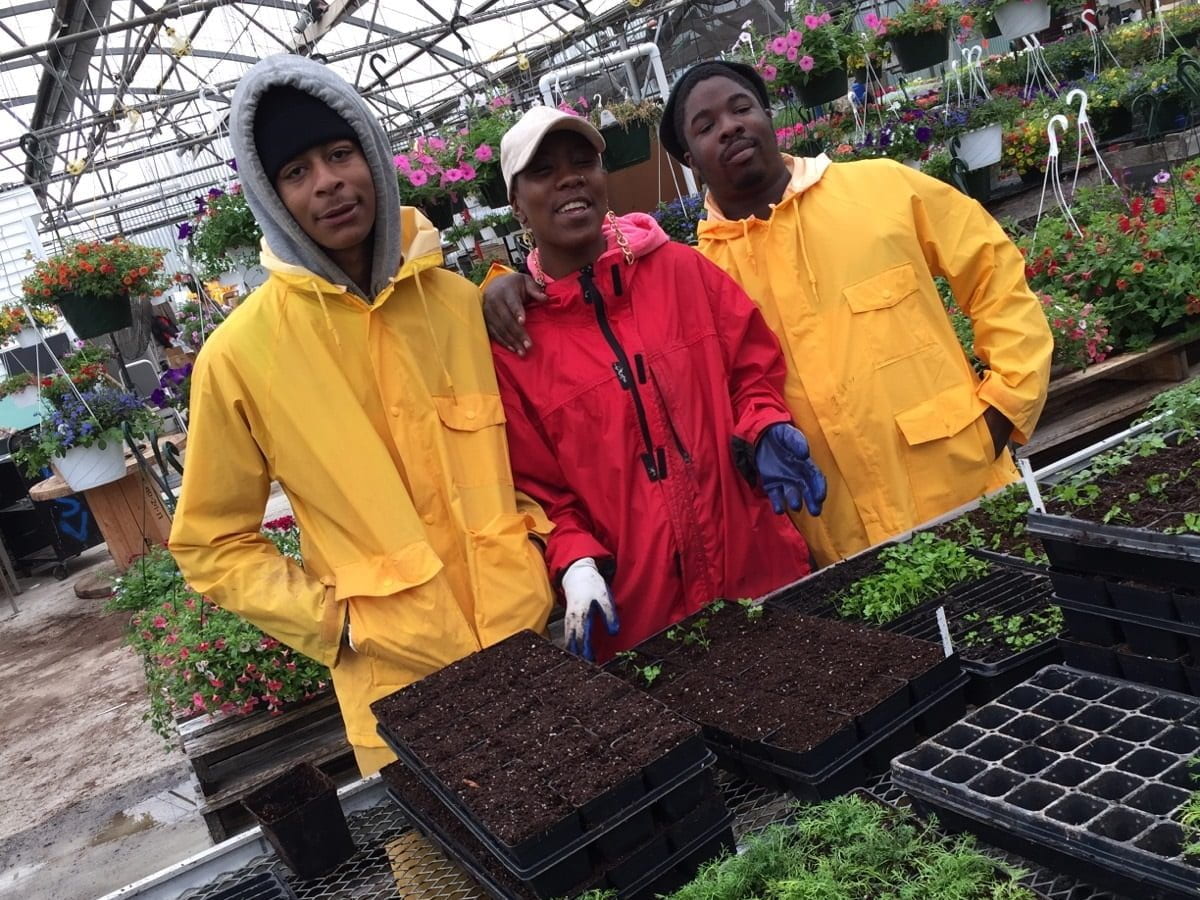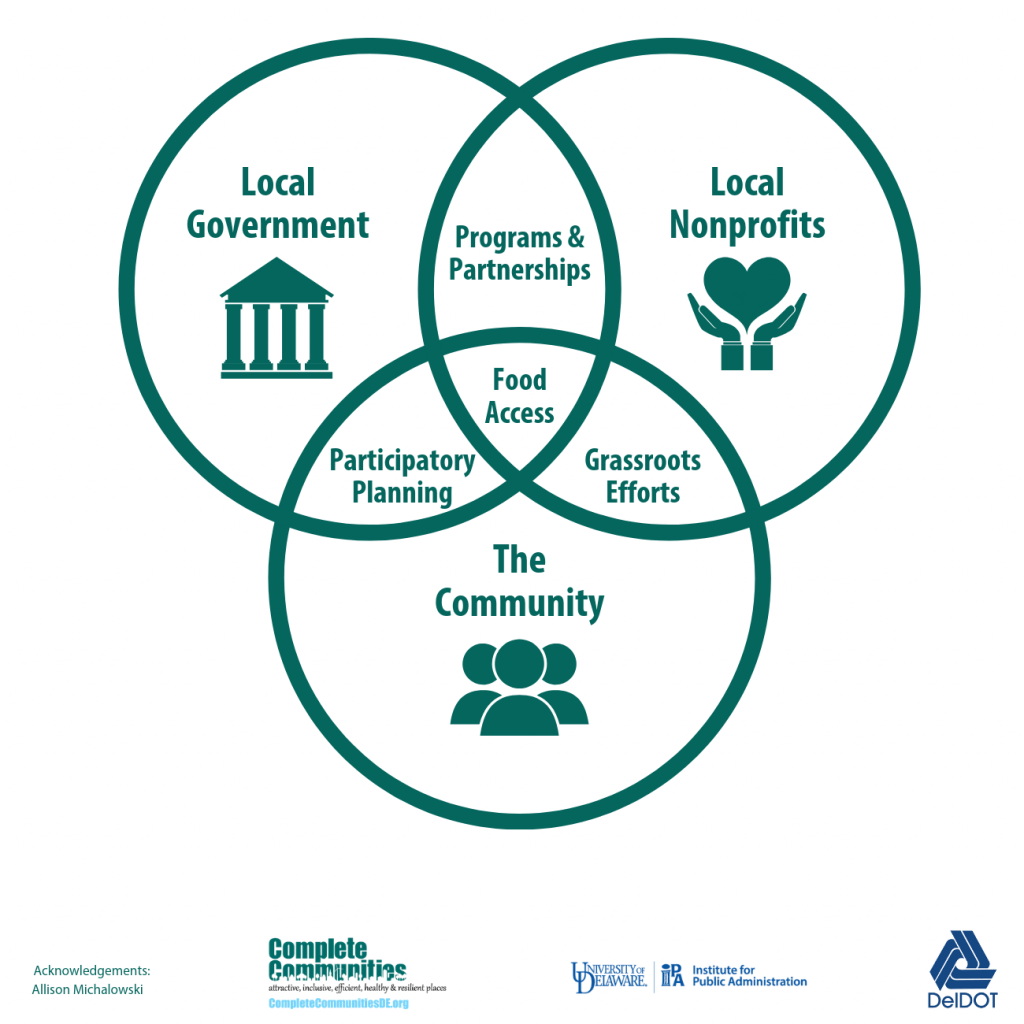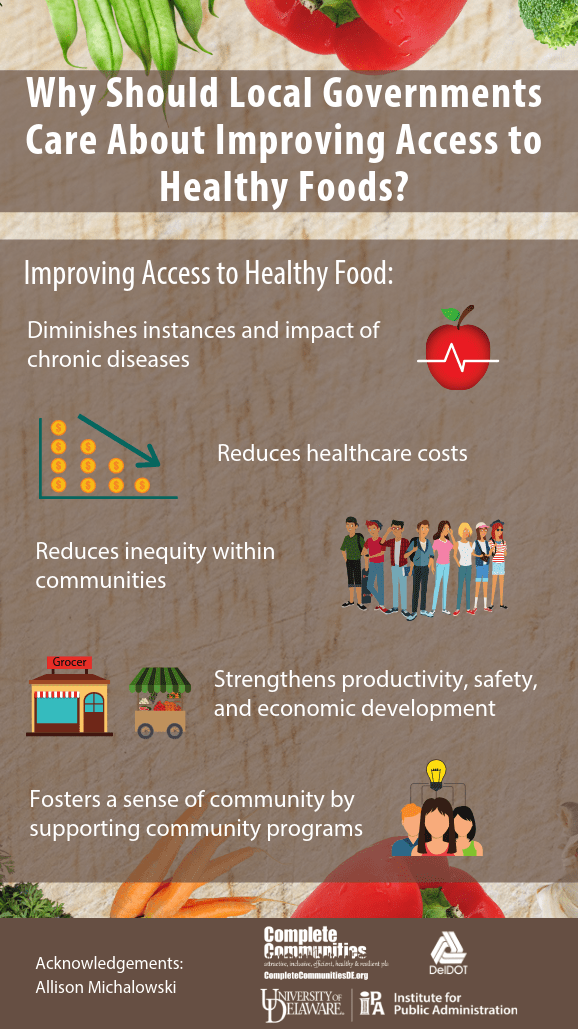 Having access to healthy foods is essential for maintaining a healthy lifestyle. For decades, millions of Americans—especially those living in low-income communities—have suffered as grocery stores with fresh, affordable food have disappeared from their neighborhoods. Without access to healthy foods, a nutritious diet and good health are unattainable. And without grocery stores and other fresh-food retailers, communities are missing the commercial centers that help local economies thrive.
Having access to healthy foods is essential for maintaining a healthy lifestyle. For decades, millions of Americans—especially those living in low-income communities—have suffered as grocery stores with fresh, affordable food have disappeared from their neighborhoods. Without access to healthy foods, a nutritious diet and good health are unattainable. And without grocery stores and other fresh-food retailers, communities are missing the commercial centers that help local economies thrive.
Access to Healthy Food in Delaware
The increasingly alarming rates of obesity and related chronic diseases that may be linked to poor diets, such as diabetes and heart disease, have become a major public health concern in the United States and in Delaware. According to the 2018 State of Obesity Report by the Robert Wood Johnson Foundation, Delaware’s adult obesity rate of 31.8 percent ranks as the 23rd highest obesity rate across the country. Delaware has the 6th highest obesity rate among children between the ages of 10 and 17. Health problems associated with obesity are also prevalent across Delaware. For example, Delaware has the 14th and 11th highest rates of diabetes and hypertension respectively.
A community food environment that promotes cheap, easily accessible unhealthy food through high levels of unhealthy food retailers increases the risk for obesity and other health conditions associated with poor nutrition. Likewise, lack of access to affordable, healthy food increases the risk for these conditions. Research also shows that access to affordable, healthy food promotes better nutrition and healthy eating habits.
Nutritious eating and physical activity can provide individuals with proper nutrition and energy, the maintenance of optimal weight, and a lower risk of disease—including high blood pressure, cancer, and type-2 diabetes.
Everything You Need to Know About Access to Healthy Food
Access to Healthy Food: A Guide for Delaware Local Governments
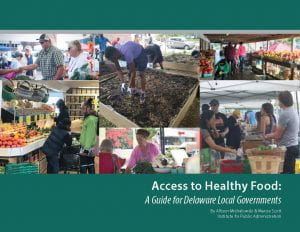 This in-depth, downloadable guide provides the reader with a thorough understanding of food access problems and innovative policy and program solutions. Most research into local-level food access policies focuses on large jurisdictions such as big cities or densely populated counties. Looking through the lens of Delaware local governments, this guide brings together research-based best practices for improving food access and adapts them to make them accessible for Delaware local governments whose size, structure, and resources vary in comparison to the large jurisdictions at the center of most healthy food access research. In addition to acting as a practical tool for Delaware local governments, the tools in this guide are versatile resources that can help community organizations and local governments in other states use planning, policies, and programming to improve access to healthy food in their communities.
This in-depth, downloadable guide provides the reader with a thorough understanding of food access problems and innovative policy and program solutions. Most research into local-level food access policies focuses on large jurisdictions such as big cities or densely populated counties. Looking through the lens of Delaware local governments, this guide brings together research-based best practices for improving food access and adapts them to make them accessible for Delaware local governments whose size, structure, and resources vary in comparison to the large jurisdictions at the center of most healthy food access research. In addition to acting as a practical tool for Delaware local governments, the tools in this guide are versatile resources that can help community organizations and local governments in other states use planning, policies, and programming to improve access to healthy food in their communities.
Access to Healthy Food in Delaware Spark Page
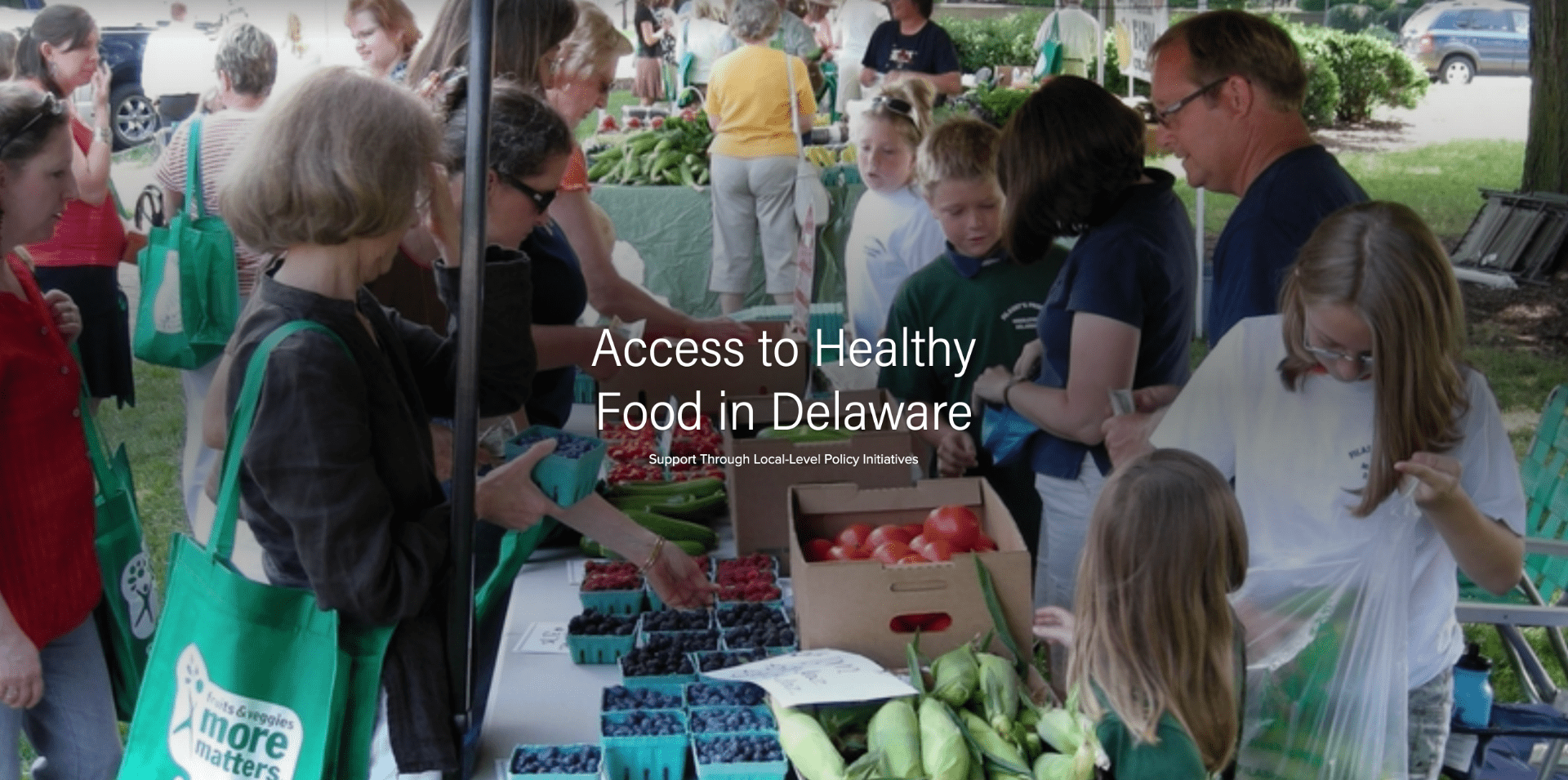 Using the visually engaging format of a Spark Page, this tool highlights how local governments can improve access to healthy food through comprehensive plans and community design, policies and regulatory tools, and local partnerships. With a focus on practical implementation, this Spark Page is an especially useful resource for those looking to identify the next steps to improving food access in their community.
Using the visually engaging format of a Spark Page, this tool highlights how local governments can improve access to healthy food through comprehensive plans and community design, policies and regulatory tools, and local partnerships. With a focus on practical implementation, this Spark Page is an especially useful resource for those looking to identify the next steps to improving food access in their community.
Infographic Gallery
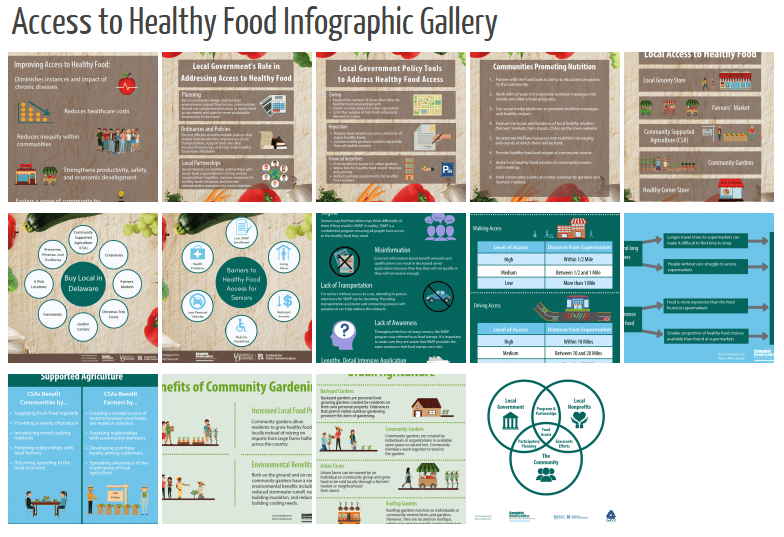 Eye-catching and informative, infographics can complement presentations and publications or serve independently as promotional material for policies and programs. Each of these infographics breaks down important access to healthy food topics into key points with visuals that make the information more understandable and memorable. Visit the Access to Healthy Food Infographic Gallery to find all the food access infographics in one place. Feel free to share and use these infographics to help your community provide for accessible and affordable healthy food.
Eye-catching and informative, infographics can complement presentations and publications or serve independently as promotional material for policies and programs. Each of these infographics breaks down important access to healthy food topics into key points with visuals that make the information more understandable and memorable. Visit the Access to Healthy Food Infographic Gallery to find all the food access infographics in one place. Feel free to share and use these infographics to help your community provide for accessible and affordable healthy food.
Topics in this section:
- Understanding Food Availability
- Improving Access in Delaware
- Transportation and Food Access
- Aging and Food Access
- Working with Local Farmers
- Reducing Exposure to Unhealthy Food
- Promoting Nutrition
- Innovative Food Access Programs in Delaware
- The Food Bank of Delaware
- Local Level Policy Initiatives
- Where to Go from Here
Understanding Food Availability
The community food environment plays a key role in determining access to healthy food. When evaluating a community food environment, many factors should be considered such as the amount of food retailers, types of food retailers, relative location of food retailers, and transportation options. Food deserts and food swamps are two terms used to describe the layout of food environments and the relationship between healthy and unhealthy food retailers in a community.
Food Deserts
According to the USDA, a “food desert” is a community,  particularly lower-income neighborhood, where residents have low (or limited) access to affordable, quality, and nutritious food. Nutritious foods are defined as those that follow the USDA’s Dietary Guidelines for Americans, a tool that is designed to encourage the consumption of nutritious foods by balancing calorie intake and by choosing more natural, non-processed foods.
particularly lower-income neighborhood, where residents have low (or limited) access to affordable, quality, and nutritious food. Nutritious foods are defined as those that follow the USDA’s Dietary Guidelines for Americans, a tool that is designed to encourage the consumption of nutritious foods by balancing calorie intake and by choosing more natural, non-processed foods.
Using the USDA guidelines, the table to the right shows the relationship between distance from a supermarket and food access level in both rural and urban communities.
Low-income and predominantly minority communities are affected the most by food insecurity. One nationwide study found that zip codes comprising low-income households have 25 percent fewer supermarkets than zip codes comprising middle-income households. Additionally, African-American populations have half as much access to chain supermarkets as Caucasian populations when controlling for other factors.
To see where these food deserts are located, visit the USDA’s Food Access Research Atlas website, which maps out the locations of food deserts in areas you define from a single city or state to the entire country.
Food Deserts in Delaware
In 2015, the Institute for Public Administration published a policy brief, Access to Healthy Foods in the Built Environment. It states,
Although the Delaware Department of Agriculture (DDA) reports that the state ranks first in the country in agricultural production value per farm and per acre, Delaware’s communities reflect food access issues similar to the rest of the country. Of the 215 census tracts in Delaware, 142 census tracts (containing 61 percent of the population) lack a grocery store. An additional 56 census tracts (containing approximately 27 percent of the population) have only one grocery store.
A Food Desert-Related GIS map was produced by IPA in June 2015 and provides a geographic overview of Delaware food desert locations by census tracts, based on USDA Food Access Research Atlas data. As noted in the policy brief, food access is not limited only to built environment nuances and geographic factors, as reflected in the USDA’s use of neighborhood and individual factors in determining food access. Additional factors that play a role are
ability to pay for and the affordability of healthy foods; having the necessary skills and equipment to make healthy meals; and having the free time to shop for and prepare healthy meals. To increase healthy eating, it is not only necessary to increase and improve supply, but also to increase demand of healthy foods via promotion and education.
For more information on food deserts in Delaware and how they affect the health and well-being of communities, read: Health Policy Issue Briefs 3 and 4 by the Institute for Public Administration.
Food Swamps
According to Johns Hopkins School of Public Health, “A food swamp is a place where unhealthy foods are more readily available than healthy foods.” Food swamps contain many unhealthy food options at fast food restaurants, corner stores, and food trucks. Each of these establishments sells food high in calories, fat, sugars, and other compounds that should be consumed in more moderate amounts.
While many food deserts contain food swamps due to the lack of healthy food options, food swamps are also present in areas that are not defined as food deserts. Some areas may have access to grocery stores and farmers’ markets, but if these healthy food outlets are significantly outnumbered by stores that sell predominantly unhealthy foods the area is still considered a food swamp. A recent study found that the correlation between food swamps and obesity is stronger than the relationship between food deserts and obesity.
Access to healthy food and nutrition habits are more complicated than the presence or lack of a nearby grocery store. The ratio of healthy and unhealthy food available plays a major role in defining the food environment and shaping dietary behaviors. When unhealthy food retailers, like fast food restaurants and convenience stores that primarily sell unhealthy foods, are more prevalent than healthy retailers, unhealthy foods are more accessible to community members than healthy foods. Likewise, these retailers tend to sell these unhealthy foods at lower prices making them both convenient and affordable.
In summary, to build a food environment that supports good nutrition and equitable access to healthy food, policies and programs should work not only to establish a point of access to healthy food in a community, but also to shift the ratio of unhealthy and healthy food retailer toward a greater presence of healthy food retail. Communities should work to increase the presence of many types of healthy food retailers, promote affordable healthy food, and decrease the prevalence of and exposure to unhealthy food retail.
Improving Access in Delaware
Affordability and travel distance are both primary factors of food access. In order to increase access to food for Delawareans, programs should be targeted at affordability and proximity of healthy foods within the context of the local community.
Locally-Driven Assessment and Policies
Building sustainable connections between residents and local sources of healthy food forms the foundation of successful food access programs. As such the best strategies to improve food access do not assess and target food access issues in isolation, but rather assess community dynamics, build on community strengths, and empower communities. Maintaining a strong emphasis on the community context throughout the implementation of policies and programs creates an impetus for residents to redefine their sense of community to include access to healthy food. This change in residents’ expectations of their community creates the framework for sustainable access to healthy food because it demonstrates that the community is capable of providing access to healthy food and establishes access to healthy food as a long-term priority.
While the depth and breadth of local knowledge may vary by type of government, the locality, and the policies being considered, improving access to healthy food necessitates an understanding of local dynamics. For example, the key to finding a successful solution may originate in understanding how and why access to healthy food became problematic in the community. This may involve understanding the history of the community from development to population growth to business policies. To understand the best way to implement potential solutions, it is crucial to identify which organizations, such as nonprofits, community centers, and faith institutions, have strong ties to the community. Likewise, when building connections between residents and local sources of healthy food, it is important to know what sources of healthy food are locally available. The figure to the right illustrates key local sources of healthy food that should be considered when assessing the status of healthy food access and when designing policies to improve access.
Healthy Food Proximity
Fast food restaurants and convenience stores are found in greater numbers in low-income communities than grocery stores with healthy food options. Without reliable transportation, residents are limited to local food retailers.
To address health food proximity, residents need to be connected with local sources of healthy food. In addition to traditional food sources like supermarkets, efforts should focus on connecting residents with resources like farmers’ markets, healthy corner stores, and community gardens. Residents also need access to food pantries. A report by the USDA showed that 28 percent of food insecure households use food pantries. For low-income individuals, these pantries provide essential services, so it is important to make sure those who need to use food pantries can access them. Thus, it is important to ensure that food pantries are both present in communities and located along connected transportation networks.
Additionally, rural communities often do not have the population density to sustain grocery stores within walking distance of all residents. Several strategies, including improved access to transportation for rural residents and rotating public markets among several locations across town, can help address these food access issues in rural communities.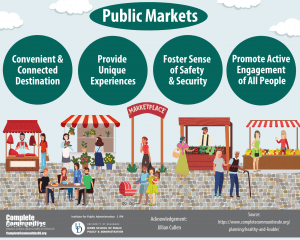
Healthy Food Affordability
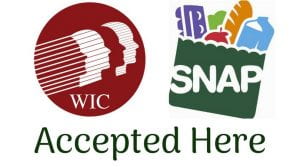
Feel free to change the border widt /> SNAP and WIC logos used to show customers where SNAP and WIC are accepted.
Credit: Capitol City Farmers’ Market
Healthy food choices are more expensive than unhealthy food. Large chain supermarkets offer lower prices than convenience stores. When the price of a food, healthy or unhealthy, is decreased, more people will buy that food. If unhealthy foods are frequently being sold at much lower prices than healthy foods, studies have shown that people are more likely to buy the unhealthy foods.
Another important aspect of affordability pertains to accepting Supplemental Nutrition Assistance Program (SNAP) and Women,Infants, and Children (WIC) benefits. Many low-income citizens rely on SNAP and WIC benefits to purchase their food. These forms of payment require special technology to process them. While chain supermarkets almost always accept SNAP and WIC benefits, there is greater variety in acceptance of these benefits among other food sources like corner stores, farmers’ markets, and farm stands. Increasing the proportion of food retail locations that accept SNAP and WIC benefits is an important component of making healthy food more affordable.
Finding Solutions
Across Delaware, many programs are addressing both the affordability and proximity of healthy foods. A major theme in several successful programs is the emphasis on buying and producing locally. In the following sections, several of these examples, including farmers’ markets and community gardens, will be discussed. The graphic below shows the many categories of local buying options Delaware has cataloged in its Buy Local Guide to help improve awareness for opportunities to buy locally grown produce in nearby communities.
Transportation and Food Access
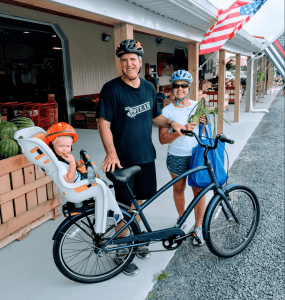
Family visiting a farmers’ market within biking distance from their residence.
Credit: Complete Communities
Accessing healthy food involves knowing there is a nearby location that offers healthy food, traveling to that location, and purchasing the healthy food. Transportation barriers break the connection between knowing that healthy food retailers exist and actually purchasing the food. Safe, accessible transportation plays a key role in linking people to healthy food.
Active Transportation
Over the course of several decades, transportation infrastructure in Delaware and across the country has emphasized automobile travel with little regard to other forms of transportation. For those without cars, forms of active transportation like walking and biking are essential forms of travel. To ensure access to healthy food for people of all ages, abilities, and incomes, communities need to establish accessible and connected pedestrian and bicycling networks that link to sources of healthy food. Communities can improve the viability of active transportation by focusing on two areas: healthy food proximity and activity-supportive built environments.
Healthy Food Proximity
Cars allow people to quickly travel long distances with ease during all seasons, but without access to a vehicle, it is difficult to regularly travel long distances. In cities and other densely populated areas, many residents do not have regular access to a car. The USDA considers healthy food retailers inaccessible in urban areas if they are more than half a mile or a mile away from people’s homes. When healthy food retailers are located beyond this distance, the amount of time required to travel to and from the store can be challenging for people who are often managing busy jobs, families, and more. Additionally, it is difficult to carry any significant amount of groceries over a long distance, so people would have to travel the lengthy, time-consuming distance to the grocery outlet more often than if it were located nearby.
Communities can address these problems by:
- Creating ordinances and zoning regulations that permit local food sources like farmers’ markets, community gardens, and Community Supported Agriculture (CSA) in more areas.
- Incentivizing corner stores and mobile food vendors to sell healthy food by offering reduced permit and licensing fees to retailers who chose to sell predominantly healthy food.
- Providing density bonuses and reduced fees to developers who incorporate a community garden into new development.
- Working with partner organizations to establish local food banks for nearby residents.
Activity Supportive Built Environments
Active transportation is any human-powered mode of transportation such as walking or bicycling. Activity-supportive built environments not only increase physical activity, but also promote transportation equity for people who do not drive or own cars. Planning for activity- supportive infrastructure goes beyond the simple existence of sidewalks and bike lanes. For activity transportation to be a viable option, activity-supportive infrastructure must be designed with key origins and destinations in mind. To provide more equitable access to healthy food, these features form continuous, safe linkages from where people live to sources of healthy food.
Communities can foster active transportation by:
- Creating and maintaining a continuous network of sidewalks and trails.
- Providing bicycle infrastructure, bike lanes, and bike
- Ensuring sidewalks and intersections are compliant with Americans with Disabilities Act (ADA) standards for accessible design.
- Planning and implementing complete streets policies to provide safe mobility options for people of all ages and abilities.
- Providing streetscaping amenities like lighting and benches.
- Implementing traffic-calming measures to reduce pedestrian- vehicle conflicts.
For more information on planning for activity-friendly environments, see the Walkability, Bikeability, and Complete Streets sections of the Delaware Complete Communities Planning Toolbox.
Public Transit
Supermarkets carry a wide variety of healthy food during Delaware’s growing season and at other times of the year. During winter and early spring, farmers’ markets, farm stands, and community gardens are not able to provide as much healthy food, but supermarkets continue to offer a variety of healthy food options because their size enables them to afford to purchase foods from other areas of the country. Public transit can connect people living in densely populated areas with large-scale supermarkets, which are often located outside of urban areas. However, the Federal Highway Administration estimates that people are only willing to walk one-quarter to one-half mile to get to mass transit, so if stops are beyond this point, residents are unlikely to view mass transit as a practical form of transportation. With careful planning and modification, public transit can provide practical and accessible connections to healthy food retailers.
The “First- and Last- Mile Transit Connectivity” video builds on the importance of considering public transit in the land use planning together and describes key factors to consider when trying to establish public transit as a viable option to connect people to important destinations.
Communities can improve access to healthy food via public transit by:
- Considering food access and distribution while working with the local transit agency (i.e., DART First State) to plan, expand, and improve the public transit system.
- Planning for the development of new healthy food retailers along existing transit lines.
- Identifying and addressing first- and last-mile transit connectivity (i.e., walking, biking, or rolling to or from a transit hub or location).
Rural Transportation
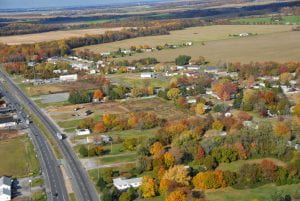
For those who live in rural areas and do not own vehicles, distance and a lack of active transportation infrastructure (sidewalks, bike lanes, crosswalks, etc.) can make it difficult to reach a food retailer.
Credit: James Pernol
According to rural residents, “lack of transportation infrastructure” is regarded as the biggest obstacle to accessing healthy food. While vehicle ownership rates are higher among rural residents than urban residents, there are many residents who lack regular access to a vehicle. Additionally, for multi-member households with only one car, it can be difficult to make long trips to the grocery store when other household members may need the car to travel to work, child-care locations, or any other number of competing uses. Since supermarkets are farther away in rural areas than they are in urban or suburban areas, supermarket trips require more travel time than elsewhere.
Communities can improve access to transportation to healthy food retailers in rural areas by:
- Encouraging farm stands to sell produce directly from farm properties.
- Offering mobile food markets run by supermarkets or nonprofits.
- Providing public transportation by means of community vans, which offer a cheaper alternative to buses in areas with lower populations.
- Partnering with nonprofit organizations that offer transportation (e.g., senior centers or community centers) to sponsor trips to full-service grocery stores or host on-site mobile markets.
Aging and Food Access
While 12 percent of the population faces food insecurity, 16 percent of seniors are food insecure. With a higher proportion of adults over 65 than the national average, Delaware needs to ensure that its seniors have access to healthy, nutritious food. In addition to facing the same challenges all community members face when accessing healthy food, seniors tend to face additional obstacles due to limited mobility and reduced income.
Mobility Barriers to Healthy Food Access Among Seniors
As is the case for the population as a whole, the ability to travel to healthy food retailers plays a key role in access to healthy food among seniors. In addition to the transportation barriers faced by all members of the community, seniors tend to encounter many mobility barriers at higher rates than the rest of the population. These challenges include:
- Mobility Disabilities and Health Problems: As people age, they are more likely to develop disabilities and health problems that limit mobility by making movements such as walking and biking more difficult or impossible. These mobility limitations can make it difficult for seniors to travel to and navigate within healthy food Similarly, weakness and reduced motor control make carrying groceries and cooking food more difficult.
- Less Personal Vehicle Access: Senior households are less likely to own cars than other households. Additionally, many people lose the ability to drive safely as they age. Together, these factors make it difficult for seniors to drive themselves to food retailers to obtain healthy
- Living Alone: Seniors who live alone are more likely to experience food insecurity than those who live with others. Whereas seniors in single member households must rely on themselves for daily tasks, in multi-member households, each member can use their abilities to help each other. For example, some household members may be able to assist with transportation to food retailers, provide additional income to purchase healthy food, and help cook food.
Communities can address mobility challenges among older adults by:
- Planning for aging-friendly communities where Universal Design is used in housing construction or remodeling projects to enable older adults to age in place.
- Providing citizens with information about supportive, human- services transportation offered by nonprofit organizations (i.e., Delaware senior centers and/or village-model communities).
- Planning and zoning for healthy food retailers such as supermarkets, farmers’ markets, farm stands, and community gardens near areas with large senior populations.
- Supporting in-home and community-based nutrition programs such as Meals on Wheels and these Delaware programs: City Fare, Modern Maturity Center, CHEER, and Meals on Wheels Lewes-Rehoboth.
Food Affordability for Seniors
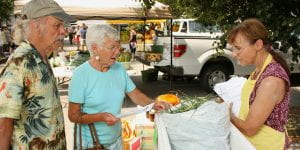
Seniors visit a farmers’ market to buy affordable, fresh produce. Farmers’ markets can offer incentives for seniors with coupons or senior days to make sure the food is affordable for seniors.
Credit: Complete Communities
Affording healthy food can be challenging for seniors who often have a reduced income. Communities can make locally grown healthy food more affordable for seniors by offering incentives for farmers’ markets and farm stands. Similar to incentives for those who receive SNAP or WIC, a senior farmers’ market incentive program typically provides seniors with an extra amount of money to spend (typically ranging from $0.50 to $2.00) for every dollar they spend on produce at a farmers’ market. Some communities choose to offer “senior days” at farmers’ market where incentives or other discounts are provided to seniors on a less frequent basis such as monthly or bimonthly.
In addition to working with local food programs, communities can make healthy food more affordable for seniors by connecting seniors with and supporting existing programs on the state and federal level that provide nutrition assistance to seniors. These programs include:
- The Commodity Supplemental Food Program (CSFP): This program, provided by the USDA, is administered by local food banks and pantries. People above the age of 60 who qualify as low-income are eligible for this program, which provides several staple food items such as fruits, vegetables, and proteins each month.
- Food Bank of Delaware Mobile Pantry: The mobile pantry provides low-income individuals of all ages with healthy food statewide. The pantry asks for community partners to contact the food bank if they are interested in hosting the pantry. Local organizations and governments can work to host the mobile pantry near areas with large populations of seniors.
- Senior Farmers’ Market Nutrition Program (SFMNP): As of 2018, SFMNP provides seniors with $20 coupons that can be used for healthy foods at farmers’ While in 2018, only four markets offered SFMNP, many more farmers’ markets intend to support the SFMNP program in 2019 and the future. Visit the Delaware Department of Agriculture website to learn more about which farmers’ markets participate in SFMNP and find out how the market in your town can become a part of this program.
Improving SNAP Enrollment Among Seniors
 Though many seniors qualify for SNAP benefits, only 42 percent of eligible seniors sign up for and receive these benefits. Considering that 83 percent of eligible residents of all ages participate in SNAP, the participation rate among seniors is unusually low. Many national groups, states, and community organizations have researched the reasons behind low senior enrollment in SNAP, and they have identified several barriers including stigma, misinformation, lack of awareness, lack of transportation to required interview, and the lengthy, detail- intensive nature of the application.
Though many seniors qualify for SNAP benefits, only 42 percent of eligible seniors sign up for and receive these benefits. Considering that 83 percent of eligible residents of all ages participate in SNAP, the participation rate among seniors is unusually low. Many national groups, states, and community organizations have researched the reasons behind low senior enrollment in SNAP, and they have identified several barriers including stigma, misinformation, lack of awareness, lack of transportation to required interview, and the lengthy, detail- intensive nature of the application.
To address some of the challenges seniors face with SNAP enrollment, the federal government has partnered with several states to implement and test the Elderly Simplified Application Process (ESAP). With ESAP, states work with the federal government to put in place procedures that make it easier for seniors to enroll in and stay enrolled in SNAP. Some examples of ESAP procedures include shorter applications, reduced re-enrollment requirements, and permission for telephone interviews rather than in-person interviews. In Pennsylvania’s first year of ESAP implementation, they received 52.2 percent more senior applications from SNAP.
As of July 2019, Delaware does not have an ESAP program in place, but communities and organizations can help address challenges associated with SNAP applications by directly assisting their seniors. The Food Bank of Delaware provides application assistance to any interested parties, so communities can connect seniors with the Food Bank.
Additionally, communities can engage in SNAP outreach that works to increase awareness of SNAP and lessen the stigma about SNAP. Improving awareness of SNAP among seniors is especially important because the SNAP program was known as food stamps for the majority of the lives of seniors who qualify for SNAP. For those who did not qualify for SNAP before retirement, there may be confusion regarding the relationship between SNAP and food stamps. Through these efforts, communities can improve SNAP enrollment and reduce food insecurity among local seniors.
Working with Local Farmers
Farmers and Farm Stands
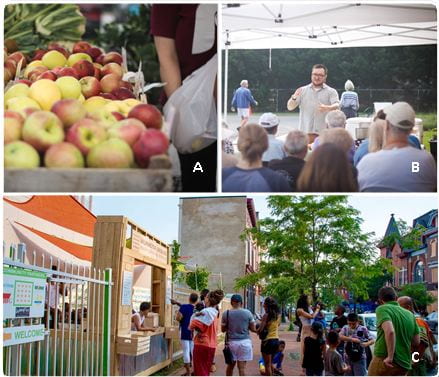
Residents learn about and buy locally grown produce at the Newark Coop Farmers’ Market (A), the Lewes Historical Farmers’ Market (B),
and the Wilmington Green Box (C).
Credit: Complete Communities (A,B); Jason Aviles, Wilmington Placemakers (C)
Farmers’ markets and farm stands both increase local access to food and support local food production. Farmers’ markets consist of multiple local farmers selling their food together at one location based on a schedule that varies anywhere from once a month to a few times a week. On the other hand, farm stands operate more consistently throughout the week and usually have only one vendor, though the produce may have been obtained from any number of farmers.
As of July 2019, the Delaware Department of Agriculture’s Buy Local Guide for Delaware stated that there are 19 farmers’ market locations and 100 farm stand locations across Delaware.
Many farmers’ markets and farm stands in Delaware now accept SNAP and WIC benefits, and the Buy Local Guide specifies whether or not these locations accept such benefits. For communities where local farmers’ markets and farm stands don’t accept SNAP and WIC, helping these markets become qualified to accept the benefits will help improve access to healthy food for families living in poverty.
Farmers’ markets and farm stands primarily sell healthy foods, and they are often located within walking distance of populated urban areas. Communities can use local ordinances to help promote farmers’ markets and farm stands by changing zoning to be more permissive for such events and by incentivizing programs through tax breaks or administrative assistance. For example, local governments can amend zoning codes to define farmers’ markets as a type of use and classify farmers’ markets as conditional uses in residential areas rather than limiting them to commercial areas.
In addition to increasing access to food, farmers’ markets and farm stands benefit local farmers and the community by increasing spending on locally produced food. Supermarkets tend to rely on fruits and vegetables imported from across the country; whereas farmers’ markets and farm stands bring food from farmers directly to nearby communities. Several farm stands like Wilmington Green Box, Urban Acres, and Bright Spot Farms also focus on employing and training local youth.
Community Supported Agriculture
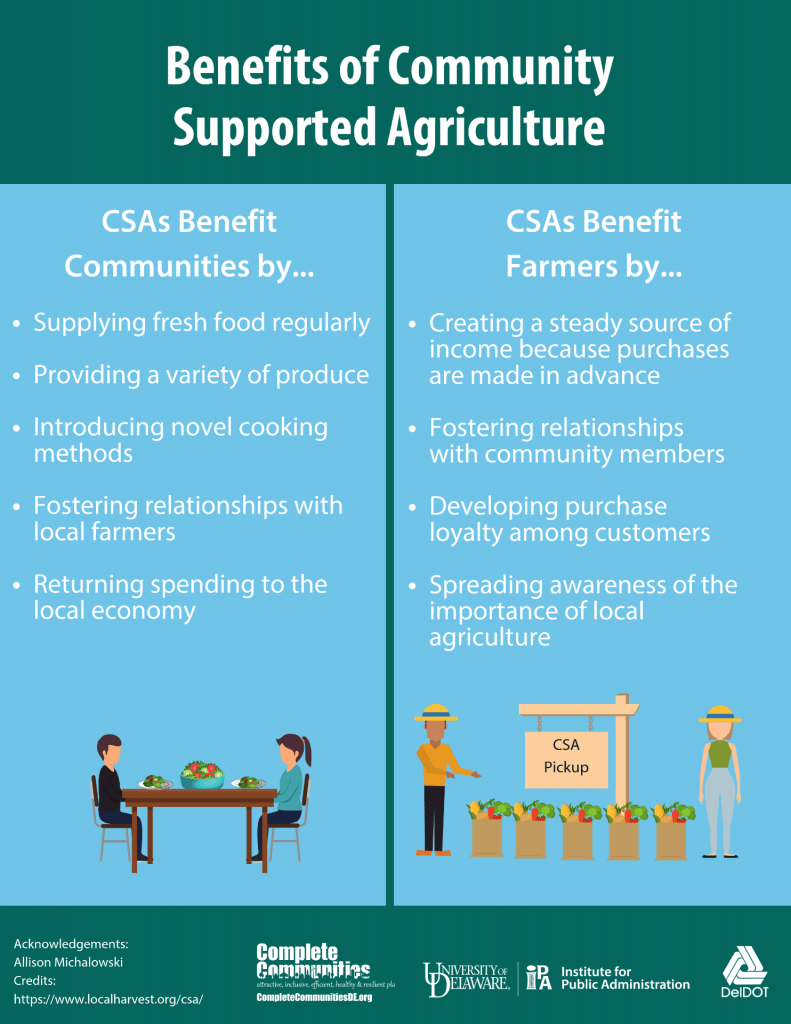 CSAs are programs that create a relationship between local farmers and residents by allowing community members to buy shares of produce at the beginning of the season in return for regularly supplied boxes of mixed produce from the local farm. Some CSAs also allow consumers to help farmers in other ways (e.g., maintaining a website or helping out on the farm) in exchange for a share of the produce. By bringing community members and local farmers together, CSA programs benefit farmers and consumers alike.
CSAs are programs that create a relationship between local farmers and residents by allowing community members to buy shares of produce at the beginning of the season in return for regularly supplied boxes of mixed produce from the local farm. Some CSAs also allow consumers to help farmers in other ways (e.g., maintaining a website or helping out on the farm) in exchange for a share of the produce. By bringing community members and local farmers together, CSA programs benefit farmers and consumers alike.
The results of a recent study provide evidence for the theory that joining a CSA improves “food lifestyle behaviors and health outcomes.” According to its findings, CSA enrollment benefitted those who reported being in poor health before joining the CSA, suggesting that CSAs could be especially helpful for improving the health of those already struggling with health problems associated with food insecurity. In contrast to visiting shops and markets, once a person buys into a CSA they are guaranteed a certain number of produce boxes throughout the growing season.
Community and Urban Gardening
There are many benefits to promoting and providing residents with greener places to live. Research suggests that green enhancements mean fewer health problems, higher property values, and more social and economic activity in the surrounding areas. Endeavors such as community and urban gardens also promote the local production of healthy food. Given findings such as these, even areas with minimal open space are beginning to find creative ways to implement gardens.
How to Garden in a City
 Although many may associate gardening and food harvesting with more rural locations such as country farms, growing food locally in urban and suburban areas has environmental, aesthetic, and health benefits for the whole community. In areas with larger populations, urban gardens can be created in open spaces and in vacant lots. Incorporating gardens into what might otherwise be a concrete jungle or blighted lot enhances the community aesthetic, creates a “sense of place” or identity, and helps to absorb water runoff. Rooftop gardens— another popular urban gardening technique—can help insulate buildings to reduce heating and cooling costs.
Although many may associate gardening and food harvesting with more rural locations such as country farms, growing food locally in urban and suburban areas has environmental, aesthetic, and health benefits for the whole community. In areas with larger populations, urban gardens can be created in open spaces and in vacant lots. Incorporating gardens into what might otherwise be a concrete jungle or blighted lot enhances the community aesthetic, creates a “sense of place” or identity, and helps to absorb water runoff. Rooftop gardens— another popular urban gardening technique—can help insulate buildings to reduce heating and cooling costs.
To help make gardening possible in local communities, cities need to create zoning rules and city ordinances that allow for the creation of community gardens in areas that may currently have strict land use rules.
Community Gardening in Delaware
Community gardens of all shapes and sizes are sprouting up across Delaware thanks to grants awarded by the Delaware Department of Agriculture (DDA) in 2016 and 2017. In 2017 alone, DDA provided local organizations with almost $18,000 in community gardening grants. For New Castle County organizations, these grants were supplemented by an additional $10,000 from the New Castle County Conservation District.
The Delaware Center for Horticulture has supported the creation of urban agriculture sites in New Castle County. Together with the University of Delaware Cooperative Extension Office and several other organizations, the Delaware Center for Horticulture successfully launched the Delaware Urban Farm & Food Coalition. Visit the Delaware Center for Horticulture’s website for the list of its affiliated urban gardens.
While the coalition’s hands-on efforts are focused on its constituents in Northern Delaware, the group offers resources to guide communities across Delaware through the process of creating and maintaining urban gardens. These resources include information about current gardens, appropriate planting and design guidelines, checklists for garden creation, and training for new gardeners.
While more attention has been focused on community gardens in New Castle County, organizations like the University of Delaware Cooperative Extension and the Boys and Girls Clubs of Delaware have worked to bring community gardens to both Kent and Sussex Counties as well. Additionally, the Healthy Food For Healthy Kids group has led efforts to create school gardens across the state. The American Planning Association worked with Kent County through the Plan4Health initiative and identified the need to create more urban agriculture as an important strategy for improving the health of Kent County residents.
For more information about how to start a community garden in your community, watch the “Starting a Community Garden” video below, which is also available on the Complete Communities YouTube channel.
Reducing Exposure to Unhealthy Food
Food environments that contain more unhealthy food retail options than healthy food retail options are referred to as food swamps. Policies that increase the availability of local retail certainly help address food swamps by increasing the number of healthy food retail options in comparison to unhealthy food retailers. However, policies that reduce the prevalence of unhealthy food retailers are also key players in the effort to shift the ratio of food retail options toward healthy food retailers.
Unhealthy Mobile Vending
![]() Since unhealthy food trucks tend to sell fatty, fried foods, the American Heart Association recommends considering the following local ordinances:
Since unhealthy food trucks tend to sell fatty, fried foods, the American Heart Association recommends considering the following local ordinances:
- Ban food trucks from operating near schools.
- Limit the locations at which food trucks are allowed to vend using zoning codes.
- Limit the times during which food trucks are approved to vend.
Without certain considerations, these efforts could negatively impact healthy mobile food vendor initiatives. One way to address the problem is by creating separate mobile licenses for those vending produce and those vending an assortment of other foods. Then each license type could be managed separately under local laws.
Zoning to Limit Fast Food
![]() According to an evaluation of local zoning laws around the country, there are several ways to use zoning to reduce the proliferation of fast food restaurants. Cities can ban the future development of fast food within specific zones entirely. Another option involves limiting the overall number of fast food outlets allowed. According to this ordinance, once that number of fast food restaurants are established anywhere in the city no more fast food development will be allowed. Communities can also work to reduce the density of fast food outlets by requiring a certain distance between each fast food outlet. Working with the Robert Wood Johnson Foundation, ChangeLab Solutions created a model ordinance to help communities legislate a healthy food zone.
According to an evaluation of local zoning laws around the country, there are several ways to use zoning to reduce the proliferation of fast food restaurants. Cities can ban the future development of fast food within specific zones entirely. Another option involves limiting the overall number of fast food outlets allowed. According to this ordinance, once that number of fast food restaurants are established anywhere in the city no more fast food development will be allowed. Communities can also work to reduce the density of fast food outlets by requiring a certain distance between each fast food outlet. Working with the Robert Wood Johnson Foundation, ChangeLab Solutions created a model ordinance to help communities legislate a healthy food zone.
Methods to Address Sugar-Sweetened Beverage Sales
![]() Recent efforts to decrease unhealthy food consumption have targeted sugar-sweetened beverages (SSBs). According to the American Heart Association, these drinks are one of the biggest contributors to unhealthy diets. As such, some municipalities are using SSB taxes, often referred to as soda taxes, to decrease consumption of these sugary drinks. Beyond taxation, there are other options to influence the sale and distribution of these drinks. Zoning and licensing regulations can be used in a similar manner to fast food restaurant regulations in order to decrease the amount of locations that can sell SSBs in designated areas. Other efforts focus more on regulating the display of beverages, so that retailers must design their environments in ways that promote the healthy beverages they offer over those that are classified as SSBs.
Recent efforts to decrease unhealthy food consumption have targeted sugar-sweetened beverages (SSBs). According to the American Heart Association, these drinks are one of the biggest contributors to unhealthy diets. As such, some municipalities are using SSB taxes, often referred to as soda taxes, to decrease consumption of these sugary drinks. Beyond taxation, there are other options to influence the sale and distribution of these drinks. Zoning and licensing regulations can be used in a similar manner to fast food restaurant regulations in order to decrease the amount of locations that can sell SSBs in designated areas. Other efforts focus more on regulating the display of beverages, so that retailers must design their environments in ways that promote the healthy beverages they offer over those that are classified as SSBs.
Promoting Nutrition
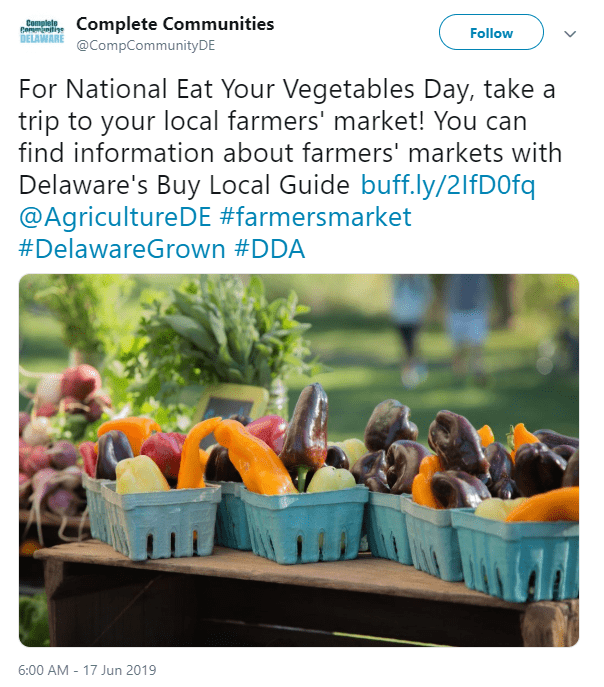
Social media can promote your own events and connect your target audience with other helpful resources. Make sure to take advantage of the ability to share links, tag partners, and include relevant hashtags.
Credit: Complete Communities
In communities where access to healthy food has historically been low, it is helpful to couple food access policies with a public health campaign for nutrition. Nutrition campaigning reinforces a demand for fruits and vegetables in the community. Not only will this make retailers more confident about their ability to sell produce, but it will also help encourage awareness about new healthy food options.
Advertising the locations and hours of farmers’ markets, farm stands, healthy cornerstones, and CSAs is one way to promote healthy eating. Communities can campaign for healthier eating by providing comprehensive nutritional information. Social media and websites offer helpful platforms for distributing messages about healthy eating. Towns can share social media posts from the USDA, healthy recipe websites, and other sources of nutritional information.
Use these tips to promote nutrition at the community level:
- Partner with the food bank to bring its educational programs to the community.
- Work with schools to incorporate nutrition messages into events and after school programs
- Use social media platforms to promote nutrition messages and healthy recipes.
- Feature the hours and locations of local healthy retailers (farmers’ markets, farm stands, CSAs) on the town website.
- Incorporate MyPlate resources into nutrition messaging and events at which there will be food.
- Provide healthy food and recipes at community events.
- Invite local healthy food retailers to community events and meetings.
- Hold community events at or near community gardens and farmers’ markets.
Holding workshops, community gardening days, and other events can also help spread the word about the importance of healthy eating. For guidance in carrying out a nutrition campaign, visit nutrition.gov, which contains helpful resources like “Smart Nutrition 101,” “MyPlate resources,” “Printable Materials and Handouts,” and more.
Innovative Food Access Programs in Delaware
Across Delaware, programs work to improve access to healthy food by using innovative solutions that address food access challenges in a variety of contexts. While nonprofit organizations lead many of these programs, local and state government support for these programs plays a key role in helping them successfully reach and impact Delaware residents. For example, local and state governments can:
- Promote awareness and use of food access programs by using media and other resources.
- Ensure that zoning codes and other ordinances support programs that improve food access by means of local food production.
- Allow programs to use public space for local food production and sale, including community gardens and farmers’ markets.
- Provide funding for programs.
This section will explore several ongoing, innovative food access programs in Delaware. While nonprofits run many of these programs, keep in mind the government policies that allow them to flourish such as zoning that allows for farmstands, farmers’ markets, and community gardens.
Wilmington Green Box
Since 2016, the Wilmington Green Box has worked to bring people together and provide affordable, nutritious food right in the heart of Downtown Wilmington. Along side the fresh produce they provide, Wilmington Green Box sells a variety of healthy items such as freshly pressed juices and salads using fruits and vegetables from local producers. In addition to addressing the food desert problem by providing access to healthy food and nutrition education in Wilmington, the founders sought to help at-risk-youth. Several teens have been hired to serve in a variety of positions for the program. Beyond selling the produce and engaging with the community, these teens learn supervisory and entrepreneurial skills.
The Wilmington Green Box has been so well received that it has been able to expand its reach each year since it opened. In addition to hiring more at-risk-youth, community support has helped the Green Box reach further into Wilmington through the addition of a mobile cart and online ordering. By 2017, the Wilmington Green Box “served more than 3,000 people—over 65 percent are African-Americans who live in the local Wilmington community.” For more information, view the “Stories of Complete Communities: Wilmington Green Box” video, which is also available on the Complete Communities YouTube channel.
Bright Spot Farms
The Westside of Wilmington is home to another creative program that works to empower the community and improve access to healthy food. Bright Spot Farms is a nonprofit venture created by the West End Neighborhood House. West End established the program in 2010 to address food access issues and train and employ foster care youth. Bright Spot Farms operates urban agriculture locations and manages their produce throughout the planting, growing, and selling phases. They sell their produce through three local farmers’ markets and their own mobile market that operates throughout the Westside of Wilmington. At each of these locations, they sell produce at half price to SNAP and WIC beneficiaries.
Each year, the program works with 25 to 30 youth. In addition to available volunteer opportunities, Bright Spot offers two programs that train and employ youth: GROW Employment Training (ages 16–24) and the Young Farmers Crew (ages 14–18). Beyond farming and produce selling skills, the programs offer many relevant job skills including GED education, Microsoft Office training, and résumé assistance. Throughout each of these programs, Bright Spot emphasizes the importance of food justice and how community members, like these youth, can be a part of addressing food justice problems. Like the Wilmington Green Box, Bright Spot Farms has helped the community thrive by empowering and educating youth while also addressing food insecurity.
Lewes Farmers’ Market Living Lab
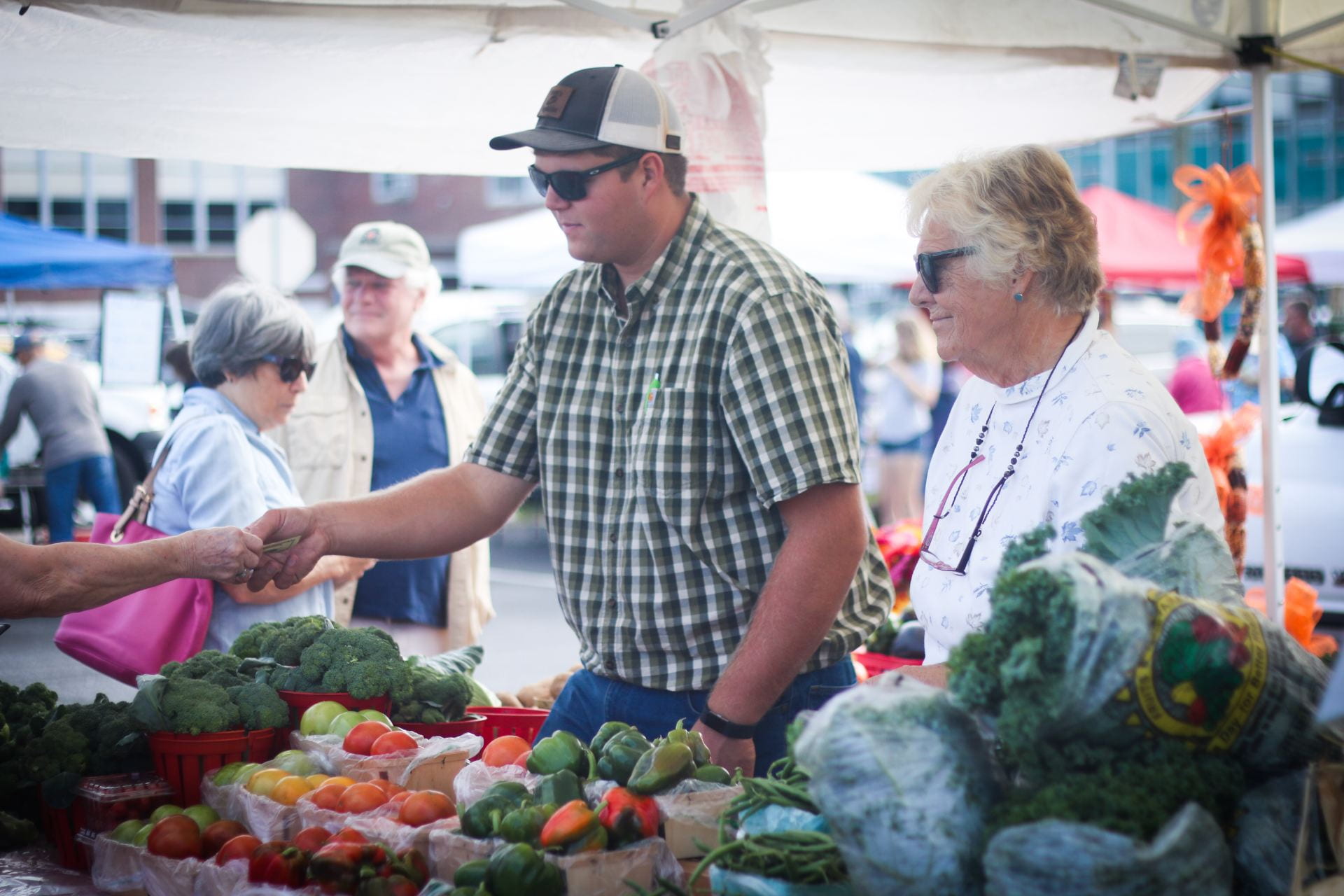
A man purchases fresh vegetables at the Historical Lewes Farmers’ Market.
Credit: Complete Communities
The Historical Lewes Farmers’ Market (HLFM) offers a novel approach to improving access to healthy food by developing methods for integrating farmers’ markets into communities. Farmers’ markets play a key role in improving access to healthy food by directly connecting local farmers with the community. However, the farmers’ market and community in Lewes understood that establishing farmers’ markets is only one part of improving access to healthy food. The HLFM sought to strengthen the farmers’ market and improve access to healthy food in the community by establishing a “living lab” that developed and tested strategies for improving farmers’ market access, sales, and attendance.
A “living lab” implements ideas in a farmers’ market and collects related data to assess the efficacy of these strategies. The mission of the HLFM calls for the market to act in “socially responsible” ways that support the community, so the “living lab” focused particularly on strategies that increase sales and attendance among SNAP participants.
After operating as a “living lab” for several years, the Lewes Farmers’ Market published Creating a Farmers Market Living Lab: Lessons Learned in Growing a Farmers’ Market. This publication details the methods the HLFM used to determine effective strategies for improving and supporting farmers’ markets. This publication is an asset to any community seeking to make its farmers’ markets accessible, affordable, and economically viable.
The publication synthesizes the experiences of farmers and market attendees and breaks down key takeaways from their experimental endeavors to provide communities with the following guidance to grow sustainable and thriving farmers’ markets:
- “How to Make Your Market a Living Lab”: Provides guidelines to develop and test strategies to improve access to and sales at farmers’ markets within the context of a unique community.
- “Lessons Learned of Interest to Farmers/Producers”: Local farmers are the backbone of farmers’ markets and local food access as a whole. These tips can provide local farmers with information that helps them form long-term, sustainable connections with the local community.
- “Lessons Learned of Interest to Market Managers”: While each stand may be run by independent producers, market-wide strategies can bring more people into the market and create a sense of community. The tips in this section help market managers to make farmers’ markets economically viable fixtures of communities.
The Food Bank of Delaware
Statewide, the Food Bank of Delaware runs several programs that approach food access from different perspectives. Working with federal grants as well as state and local governments, the Food Bank of Delaware demonstrates how access to healthy food programs can work across all levels of government in order to help all Delaware residents access healthy food.
Childhood Nutrition Program
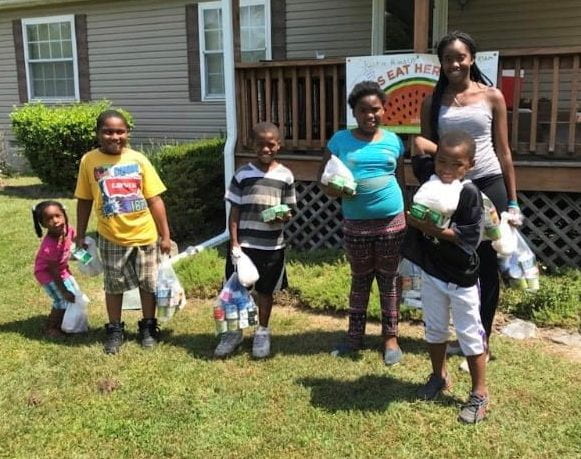
Kids show off their summer grab and go meals from the Summer Nutrition Program at Coverdale Crossroads in Bridgeville.
Credit: Food Bank of Delaware
The Food Bank runs several programs to address children’s nutrition year round. Throughout the school year, services are primarily delivered through the After-School Nutrition Program. For students in low- income areas, this program provides meals and snacks alongside educational activities after school. Knowing that children need access to healthy food during times when they are not in school such as weekends and holidays, the Food Bank established the Backpack Program. This program fills backpacks with healthy foods including both meal and snack items. During the 2017–18 school year, almost 6,000 Delaware children received these nutritiously stocked backpacks during each weekend and holiday.
To address food nutrition and security during the summer months, the Food Bank administers the Summer Nutrition Program, which works with community sites to provide free, healthy meals to children throughout the summer. Additional mobile meals programs, especially within participating school districts, were launched in the summer of 2018 and aim to reach more rural children. Families can call “2-1-1” or text “food” or “comida” to 877-877 to find summer meal sites in Delaware.
SNAP and WIC Related Programs
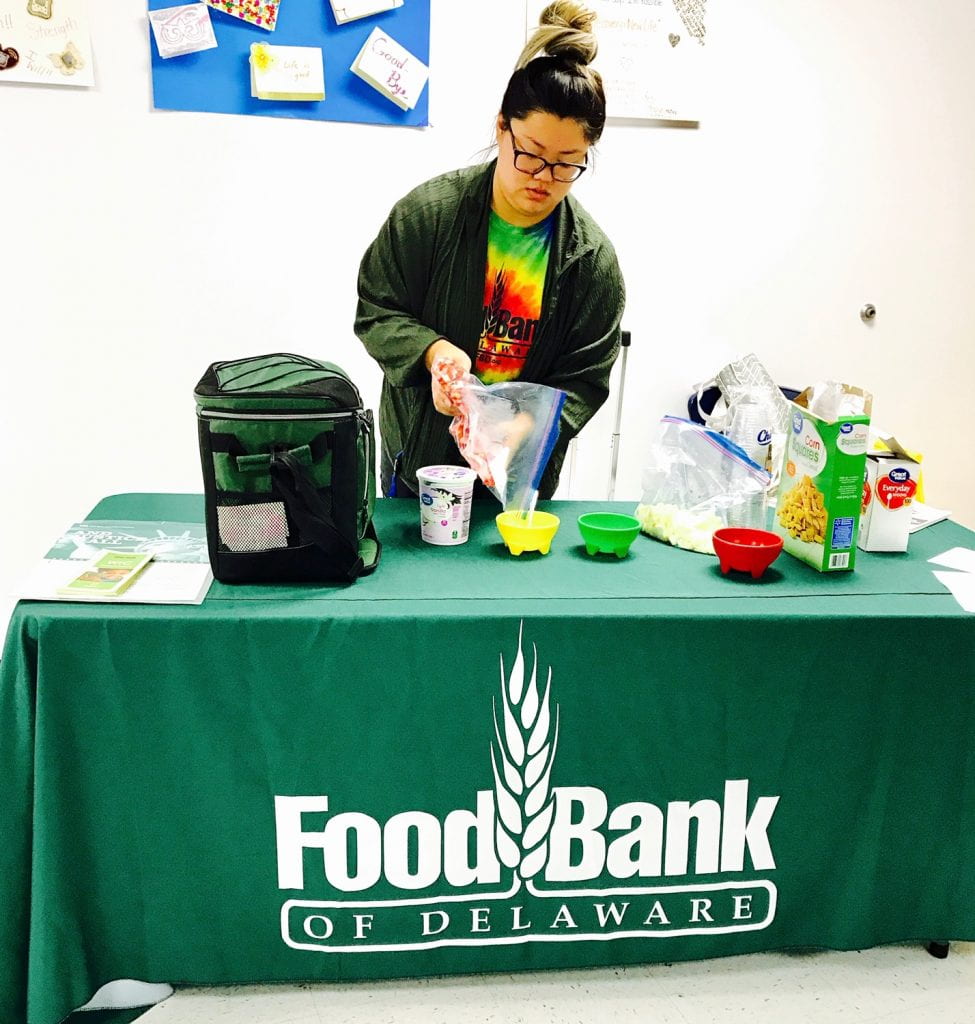
Food Bank WIC Education Specialist Chong Yi conducts a healthy eating demonstration for participants in the WIC program.
Credit: Food Bank of Delaware
The Food Bank of Delaware provides additional assistance specifically for those who qualify for SNAP and WIC supplements. For those who may qualify for SNAP assistance, the Food Bank offers application assistance during which trained professionals help people fill out the application correctly and provide guidance through the process even after the application has been submitted. Additionally, the Food Bank provides WIC recipients with WIC food packages worth $60–$135 each month. These packages are prepared with nutritious foods including fresh produce, whole grain bread, and milk.
The Food Bank designs and provides educational programs that specifically address healthy eating as a SNAP or WIC participant. Both SNAP and WIC educational outreach programs emphasize making healthy food choices with a limited budget and learning to prepare meals with healthy foods. These programs are administered at a variety of locations beyond the food bank itself including community centers, farmers’ markets, senior centers, and other locations that wish to help residents make healthy food choices. While educational programming at these locations use recipe cards, food demonstrations, and food samples to help directly educate beneficiaries, the Food Bank also provides online cooking videos to make sure that those who cannot attend educational events still have access to information about cooking healthy food on a budget. WIC-focused outreach events demonstrate cooking methods and provide recipes for each of the foods in the WIC food package to help ensure that these foods are used in nutritious and filling ways.
Mobile Pantry
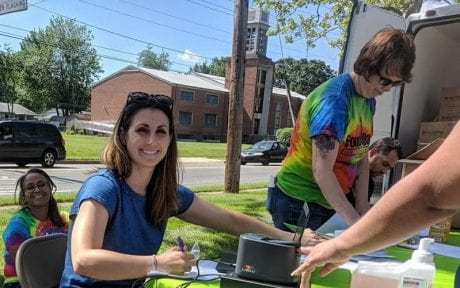
During the Food Bank’s mobile outreach, Community Nutrition Educator Gina Maresca uses a Veggie Meter to measure the amount of carotenoids (an indicator of fruit and vegetable consumption) in a client’s skin.
Credit: Food Bank of Delaware
While the Food Bank operates in many locations throughout the state, they are aware of the many transportation barriers their clients may face. To ensure that Delawareans have access to healthy food assistance regardless of their transportation status, the Food Bank runs the Kraft Mobile Pantry. From New Castle to Sussex, the mobile program provides a variety of nutritious foods including fresh produce to those in need. In addition to helping as many as 50 households access healthy food each day, the pantry provides education on “topics including nutrition, financial literacy, healthcare, and more.” The mobile pantry is always looking for sites to act as temporary distribution points, so if your community has a need, reach out to the food bank to find out how you can help.
Food-Related Workforce Development Programs

David, a graduate of The Culinary School at the Food Bank of Delaware,
working at Lupo Italian Kitchen in Rehoboth Beach.
Credit: Food Bank of Delaware
Like several other programs in Delaware, the Food Bank combines workforce development with access to healthy food. Economic security plays an essential role in food security, so these programs can help improve participants’ access to healthy food in the long term. The Food Bank runs five programs that fall into three different categories:
- Food Service: Including the Culinary School, Manage First Program, and ServSafe Certification, initiatives in this category provide participants with skills and experience that prepare them for jobs in the food service industry. The food bank provides financial assistance to those who need it, so that these programs are affordable for those who are working to become more economically secure.
- Warehousing: The L.O.G.I.C. program provides participants with training that helps them secure jobs in the warehouse industry by training them to use equipment and understand warehouse operation logistics. The program even offers two certifications: OSHA-10 General Industry Certificate and the Forklift Certificate.
- Agriculture: The newest of the Food Bank’s workforce development programs, F.A.S.T. consists of a 14-week training period during which participants engage in hands on work experience and receive training in a variety of agricultural topics like crop management, food safety, and farm business. Additionally, participants receive an hour of life skills training daily.
Local Level Policy Initiatives
Access to healthy food plays a key role in creating complete communities where everyone has the chance to be happy and healthy. From making it more difficult for children to study in school to making people sacrifice other important purchases like medications, food insecurity impacts all aspects of people’s lives. Both food insecurity and unhealthy diets increase the risk of many chronic health conditions and stress. Sprawling land use patterns and strict separation of uses have contributed to creating built environments that make it difficult for people to access healthy food. This Adobe Spark Page highlights how Delaware local governments can improve access to healthy food through comprehensive plans and community design, policies and regulatory tools, and local partnerships.
Where to Go from Here
Access to healthy food is a vital part of a complete community. Ensuring residents have access to healthy, affordable foods can fend off countless health problems, including many of the most significant chronic health conditions like diabetes, cancer, and heart disease. Furthermore, many healthy food initiatives bring people together and strengthen community bonds. As a result, these policies can not only improve access to healthy food, but they can also encourage economic development, foster innovation at the local level, and build social capital.
Applying Access to Healthy Food Tools
However, there is not one simple solution because the problem itself is not simple. Barriers to food access occur as current policies and practices interact with many other social and environmental factors like transportation and economic development. When it comes to understanding this complex problem at the local level, context is key. Using this analysis of determining factors for food access, local governments, citizen planners, and community organizations can identify factors creating barriers to food access in their communities.
Similarly, it is crucial to identify opportunities with a community context-specific approach. Unique community character is part of what allows local-level policy to address target problems alongside creating a sense of place and building social capital, but it also means there are no one size fits all solutions. There is no better way to find out which solutions would work best in a community than asking those to live there. Community engagement can help identify which policies will thrive and ensure that limited resources are spent effectively. Visit other sections of the Complete Communities Toolbox for additional tips, tools, and tech to help make your community complete.

